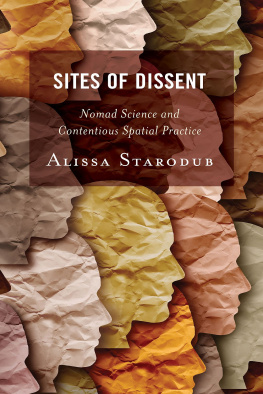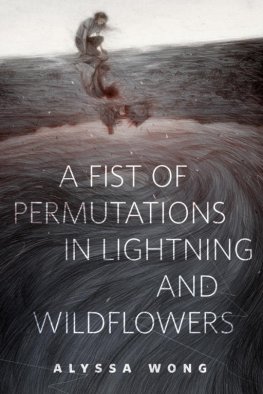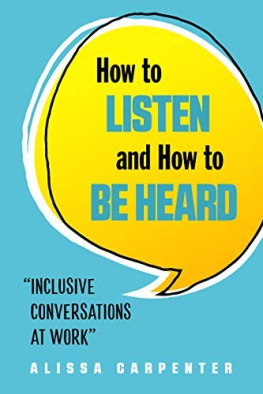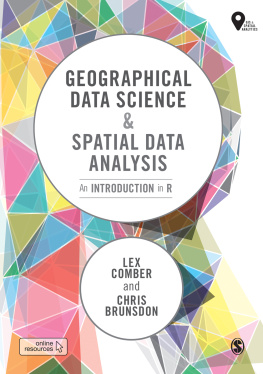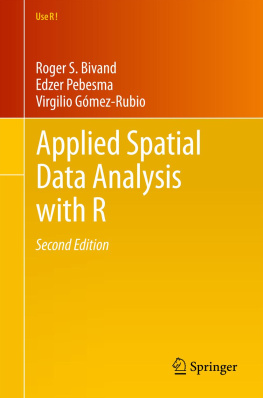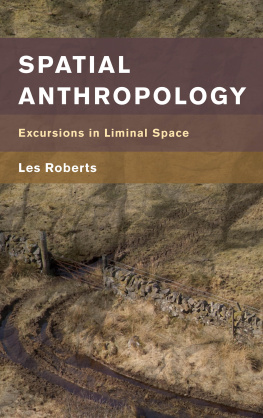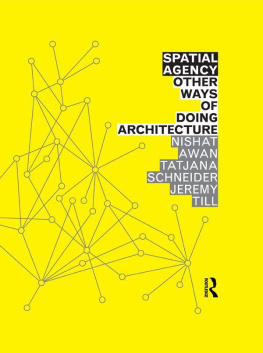Alissa Starodub - Sites of Dissent: Nomad Science and Contentious Spatial Practice
Here you can read online Alissa Starodub - Sites of Dissent: Nomad Science and Contentious Spatial Practice full text of the book (entire story) in english for free. Download pdf and epub, get meaning, cover and reviews about this ebook. year: 2021, publisher: RowmanLittlefield, genre: Politics. Description of the work, (preface) as well as reviews are available. Best literature library LitArk.com created for fans of good reading and offers a wide selection of genres:
Romance novel
Science fiction
Adventure
Detective
Science
History
Home and family
Prose
Art
Politics
Computer
Non-fiction
Religion
Business
Children
Humor
Choose a favorite category and find really read worthwhile books. Enjoy immersion in the world of imagination, feel the emotions of the characters or learn something new for yourself, make an fascinating discovery.
- Book:Sites of Dissent: Nomad Science and Contentious Spatial Practice
- Author:
- Publisher:RowmanLittlefield
- Genre:
- Year:2021
- Rating:3 / 5
- Favourites:Add to favourites
- Your mark:
- 60
- 1
- 2
- 3
- 4
- 5
Sites of Dissent: Nomad Science and Contentious Spatial Practice: summary, description and annotation
We offer to read an annotation, description, summary or preface (depends on what the author of the book "Sites of Dissent: Nomad Science and Contentious Spatial Practice" wrote himself). If you haven't found the necessary information about the book — write in the comments, we will try to find it.
Sites of Dissent: Nomad Science and Contentious Spatial Practice — read online for free the complete book (whole text) full work
Below is the text of the book, divided by pages. System saving the place of the last page read, allows you to conveniently read the book "Sites of Dissent: Nomad Science and Contentious Spatial Practice" online for free, without having to search again every time where you left off. Put a bookmark, and you can go to the page where you finished reading at any time.
Font size:
Interval:
Bookmark:

Sites of Dissent
Creative Interventions in Global Politics
Series Editors: Shine Choi, Cristina Masters, Swati Parashar and Marysia Zalewski
The landscape of contemporary global politics is complex and oftentimes violent. Yet the urgency to provide solutions or immediate practical actions to this violence oftentimes leads to inadequate knowledge. This is despite the abundance of theoretical, conceptual and methodological tools available much of this produced through conventional academic disciplines, notably International Relations, Political Theory and Philosophy. But the constraints imposed on these traditional disciplines profoundly limit their ability to incorporate and make effective use of more creative and innovative methodologies found in other disciplines and genres.
This series provides a unique opportunity to offer creative intellectual space to work with an eclectic and rich range of disciplines and approaches including performative methodologies, storytelling, narrative and auto-ethnography, embodied research methodologies, participant research, visual and film methodologies and arts-based methodologies.
Titles in the Series
Sites of Dissent: Nomad Science and Contentious Spatial Practice
Alissa Starodub
Sites of Dissent
Nomad Science and Contentious
Spatial Practice
Alissa Starodub
ROWMAN & LITTLEFIELD
Lanham Boulder New York London
Published by Rowman & Littlefield
An imprint of The Rowman & Littlefield Publishing Group, Inc.
4501 Forbes Boulevard, Suite 200, Lanham, Maryland 20706
www.rowman.com
8690 Paul Street, London EC2A 4NE, United Kingdom
Copyright 2021 by Alissa Starodub
This book is the published version of a PhD thesis at Ruhr University Bochum, 2018.
All rights reserved . No part of this book may be reproduced in any form or by any electronic or mechanical means, including information storage and retrieval systems, without written permission from the publisher, except by a reviewer who may quote passages in a review.
British Library Cataloguing in Publication Information Available
Library of Congress Cataloging-in-Publication Data Is Available
ISBN 978-1-5381-4633-0 (cloth: alk. paper)
ISBN 978-1-5381-4635-4 (electronic)
 The paper used in this publication meets the minimum requirements of American National Standard for Information SciencesPermanence of Paper for Printed Library Materials, ANSI/NISO Z39.48-1992.
The paper used in this publication meets the minimum requirements of American National Standard for Information SciencesPermanence of Paper for Printed Library Materials, ANSI/NISO Z39.48-1992.
Contents
The page of acknowledgements is a special space. Here the people who have helped to give this book its present shape, direction and texture are appreciated and mentioned to the reader. The reader has already encountered some of these people on the pages of this book my co-researchers and others involved in struggles on sites of dissent. A few lines of text would not be an adequate expression of my thankfulness to you. At different stages of making this book some of you made requests for what to put in the acknowledgements.
To thank all of you for going with me on a strange journey, all of your requests and suggestions are in here.
Kelly, right in the beginning of this research project, you asked me to promise that it will be written in a way that everyone could understand not only academics. I hope I lived up to this expectation (I tried my best) and I am incredibly grateful for the time you took to discuss this book with me.
Mart, once we took notes for one of the stories on the roof of the house where you lived, you asked me to put this in the acknowledgement: Without Mart this research project would not have been possible. Definitely.
And for Rolf who made jokes about the research method in one of the final collective discussions: Rolf wrote all this.
I equally remember to thank Professor Hans Mainusch, Frau Schlonk, Puv Love, Mattusch, J. and my sister Kata as well as Andy for sending hordes of invisible pixies from the chaos dimension to keep me working during the hard times.
Massive thanks to my two incredible supervisors, Sabrina Zajak and Sara Motta. Without your support this book would have never come into being.

Figure I.1 Artwork by Kata. Source : Authors own.
My friends Angelo, Brianof the gold extraction mine and mass trespass that took place the day before. We had taken our tent down really quickly, packed our stuff into bicycle bags and took off in the direction of our hometown. Later, we would take a train. Now, we were cycling towards the next little village whilst the sun was rising. The demonstration, the cops, the assemblies in the camp... all this was filling our heads in addition to the tiredness. None of us has said a word for a long time. After a few kilometres our pace slowed down.
Do you think the action camp was an inclusive space? asked Brian suddenly.
Why do you say this? I replied.
All these different people older people and young student-people, people who refuse to work and those who probably have an ordered life... do you think we created a space of resistance together, or do you think there were people left out out of the actions, out of the social relationships like it is always the case almost everywhere. So do you think we created some kind of better alternative?
I would say so, replied Angelo, I think that all together we created a resistive space. Or, even several. A space that resists against capitalist environmental destruction, a site of dissent. The infrastructure that we have set up with all its facilities, showers, collective kitchen, kids space... and everyone was somehow involved. On the other hand, even our utopias might reproduce some kind of exclusions.
Well, I just think we have a lot to learn because we are so different, different people. We have to study how we can find a collective ground for taking action and transforming the world. How can we find a shared language? How can we communicate why we do resistance?
We have to study ourselves, the movements, in different situations, I said, Collect information, observe carefully and then exchange our experiences in a structured way. This is exactly what I want to do with this research project you know, the book that I am writing now, I said happily.
Can we take a break soon? asked Angelo, I am half dead.
Sure. But how can you study ourselves, the movements? I dont think it is possible. Nobody can say what the movements actually is. And if it is, it will be some kind of academic thing that none of us will understand because it is written in an inaccessible language and applies some complicated research design to find out about the truth about us.
Basically, Brian is saying that you have to include us into your research, otherwise its crap. Can we please take a break and discuss this when we are off the bikes? Angelo insisted.
We were approaching the next little village. On my bike I was becoming aware that we were about to do research already, that our discussion was already part of a collective process of creating knowledge.
And the research has to be horizontal, it has to be able to include everyone who participates in creating these sites of dissent even if they cant write and never went to university. Otherwise, you will have to take an external position as if you knew everything and say: I have analysed that and this, and that that or this is the truth about autonomous movements! And it will simply not be very relevant because there are tons of other valid perspectives which you have not brought together, said Brian.
Font size:
Interval:
Bookmark:
Similar books «Sites of Dissent: Nomad Science and Contentious Spatial Practice»
Look at similar books to Sites of Dissent: Nomad Science and Contentious Spatial Practice. We have selected literature similar in name and meaning in the hope of providing readers with more options to find new, interesting, not yet read works.
Discussion, reviews of the book Sites of Dissent: Nomad Science and Contentious Spatial Practice and just readers' own opinions. Leave your comments, write what you think about the work, its meaning or the main characters. Specify what exactly you liked and what you didn't like, and why you think so.

